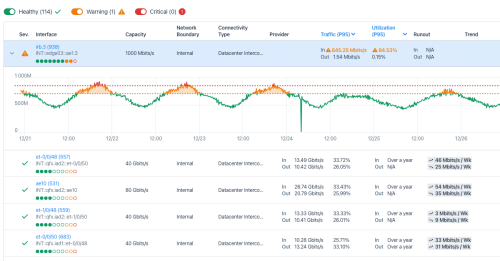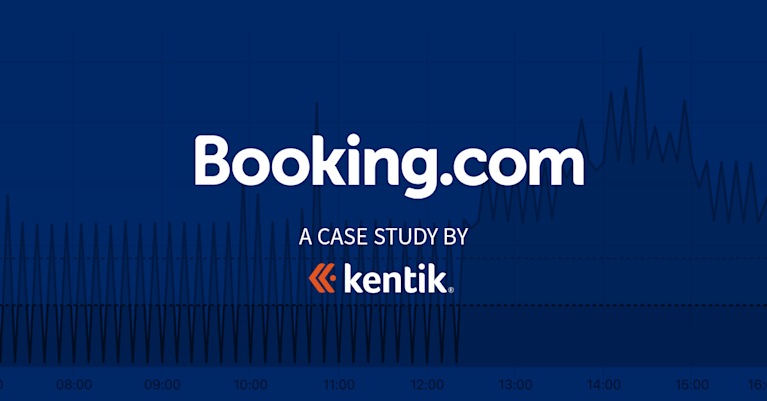Network Capacity Planning
Maintaining a robust and efficient network infrastructure is essential for network operators managing enterprise or internet service provider networks to ensure seamless business operations and satisfy user demands. As organizations grow and adapt to evolving technology landscapes, it’s crucial that their networks can handle increasing workloads while delivering optimal user experiences. Network capacity planning is a proactive approach to managing and optimizing network resources. This article introduces the significance of network capacity planning, its benefits, key metrics, and use cases.
What is Network Capacity Planning?
Network capacity planning is a systematic approach to evaluating and optimizing network resources, ensuring peak performance, availability, and efficient data transmission. By assessing current infrastructure, analyzing bandwidth usage, pinpointing potential bottlenecks, and strategizing for future growth, this proactive process helps maintain seamless end-user experiences and prevents network congestion.
Network capacity planning aims to provide users with a seamless and efficient network experience while minimizing costs and maximizing the return on investment in network infrastructure.
What is Network Capacity?
Network capacity refers to the maximum volume of data that can be transferred across a network between two points during a specified time frame. It is a crucial aspect of network infrastructure and performance, as it directly impacts the efficiency and effectiveness of data transmission, ultimately determining the quality of user experience. Network capacity is usually measured in bits per second (bps) or multiples, such as kilobits per second (Kbps), megabits per second (Mbps), or gigabits per second (Gbps).
Why is Network Capacity Planning Important?
As organizations grow and evolve, so do their networking requirements. Increased reliance on cloud services, remote work, and data-intensive applications can significantly strain network resources. Failing to plan for these changes can result in degraded performance, network outages, and unsatisfied users. Proper network capacity planning helps organizations in the following ways:
-
Ensure network performance and reliability: By proactively identifying and addressing potential bottlenecks before they impact users, network capacity planning helps maintain optimal network performance and minimize downtime.
-
Optimize resource utilization: Capacity planning allows organizations to make informed decisions about when and where to invest in network infrastructure, ensuring that resources are used efficiently and cost-effectively.
-
Forecast future network capacity needs: By analyzing historical network traffic data and trends, organizations can predict future bandwidth requirements and plan accordingly.
-
Improve network security: A well-planned network can better accommodate security measures and more effectively detect and respond to potential threats.
-
Support business growth: Network capacity planning helps organizations prepare for and accommodate growth, ensuring their network infrastructure can support increased demand and new business initiatives.
Benefits of Network Capacity Planning
Implementing effective network capacity planning provides several key benefits to network operators, including:
-
Cost savings: Organizations can reduce their overall network infrastructure costs by optimizing resource utilization and identifying opportunities for consolidation or resource sharing.
-
Improved performance: Proactively addressing network bottlenecks and capacity issues helps maintain optimal network performance and minimize the impact of network-related problems on users.
-
Scalability: Network capacity planning enables organizations to grow and expand their network infrastructure in a controlled and efficient manner, ensuring that their networks can handle increased demand without compromising performance.
-
Better decision-making: Capacity planning provides organizations with the data and insights they need to make informed decisions about network investments and resource allocation, helping them align their network strategy with their overall business goals.
-
Enhanced security: A well-planned network can better support the implementation of robust security measures and more effectively detect and respond to potential threats.
Learn more about best practices for network capacity planning in our blog post, Network Capacity Planning 101: Requirements & Best Practices.
The definitive guide to running a healthy, secure, high-performance network

Network Capacity Planning Metrics
Network capacity planning metrics are essential for monitoring and evaluating the performance of a network. They provide insights into the current state of the network, potential bottlenecks, and areas that may require upgrades. The most critical metrics to consider in network capacity planning are:
-
Utilization: This metric represents the ratio of the current traffic volume to the total available bandwidth on an interface. It is typically expressed as a percentage and indicates how much of the available capacity is being used. High utilization may lead to network congestion and poor performance.
-
Runout: Runout is an estimate of when the traffic volume on an interface will exceed its available bandwidth, given the current utilization trends. This metric helps organizations plan for future capacity needs and avoid unexpected congestion.

Additionally, the standard network performance monitoring metrics are relevant when analyzing or planning network capacity:
-
Latency: Latency measures the time it takes for a packet to travel from one point to another in the network. High latency may indicate network congestion or a need for additional capacity.
-
Packet Loss: Packet loss occurs when data packets fail to reach their destination. A high packet loss rate can significantly impact network performance and may indicate a need for additional capacity or infrastructure upgrades.
-
Error Rate: The error rate measures the percentage of data packets that are corrupted, lost, or discarded due to errors. A high error rate may indicate issues with the network infrastructure or a need for additional capacity.
Network Capacity Planning Use Cases
There are various use cases for network capacity planning, depending on the role within an organization and the network’s specific needs. Some common use cases include:
-
Network Expansion: As organizations grow, so do their network requirements. Capacity planning helps determine when and where to add new network devices, links, or connections to accommodate this growth.
-
Cost Optimization: By monitoring network capacity and utilization, organizations can identify underutilized resources and reallocate or decommission them, reducing costs and optimizing resource usage.
-
Performance Management: Capacity planning helps maintain optimal network performance by ensuring that network resources are sufficient to meet current and future demand. This enables organizations to deliver a consistent, high-quality user experience.
-
Disaster Recovery and Business Continuity: Network capacity planning is critical in developing and implementing disaster recovery and business continuity plans. By understanding network capacity and utilization, organizations can design resilient networks that can withstand and recover from unexpected events, such as hardware failures or cyberattacks.
-
Network Migration and Consolidation: Organizations may need to migrate or consolidate their networks as they evolve. Capacity planning helps evaluate the new network’s requirements, ensuring that it can support the organization’s needs without negatively impacting performance.
Network Capacity Planning with Kentik
Kentik offers a comprehensive network capacity planning solution that provides real-time visibility into network performance and utilization, enabling organizations to make informed decisions about their network infrastructure. Key features of Kentik’s capacity planning solution include:
- Built-in link utilization visualizations: Gain a clear understanding of network utilization and performance with easy-to-understand visualizations.
- Customizable reporting: Tailor reports to your organization’s specific needs and export them in various formats for easy sharing and analysis.
- Predictive analytics: Forecast future network resource requirements based on historical data and trends.
- Automated alerting: Set customizable thresholds for key performance metrics and receive alerts when these thresholds are reached.
- Integration with other tools: Enhance network visibility and streamline operations by integrating Kentik’s capacity planning solution with other network management and security solutions.
By leveraging Kentik’s powerful network capacity planning solution, organizations can proactively plan for future network needs, optimize resource utilization, and ensure their networks’ ongoing performance, reliability, and security. To learn more about Kentik’s capacity planning capabilities and how they can benefit your organization, request a demo or sign up for a free trial today.


